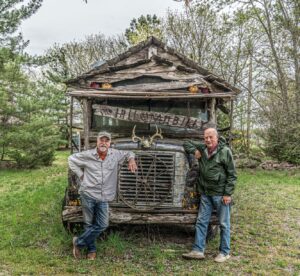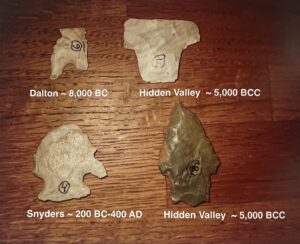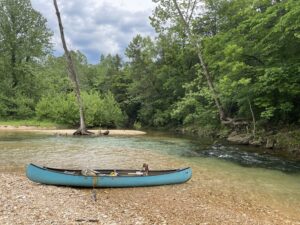April Monthly Meeting Recap:
Loring Bullard and Bob Kipfer Presented on Bull Creek
Our April Meeting was on Friday, April 5th, at the Watershed Center!
 Loring Bullard and Robert Kipfer discussed their newly published book, Saving Bull Creek, which you can purchase here.
Loring Bullard and Robert Kipfer discussed their newly published book, Saving Bull Creek, which you can purchase here.
Loring Bullard is the Watershed Planning/Grant Assistant for the James River Basin Partnership and serves on the Ozarks Land Trust Board. He served for 23 years as Watershed’s Executive Director and before that, Loring was an Environmental Health Supervisor at the Springfield-Greene County Health Department.
Robert (Bob) and Barb Kipfer own land on Bull Creek and have taken great initiatives to protect the land, involving local schools, agencies, and organizations, including Watershed and its partners. Mr. Kipfer said that he and Barbara spent their free time floating in the river when they were employed as a doctor and nurse. They purchased land along Bull Creek and began bank stabilization in 1995, working through a cooperative agreement. In this process, they learned what a riparian corridor is, and they planted 150 seedlings to improve their own corridor. He showed a photo of the stream in 1996 in contrast to one from 2016. In 2018, the couple bought more land along the creek and worked with the Department of Conservation to continue improving the property.
 Mr. Kipfer explained the history of the land, saying they found artifacts, including arrowheads. These were studied by Missouri State University and show evidence of Native Americans traveling through around 7,000 BC to 500 AD. He mentioned Henry Rowe Schoolcraft’s account of the land in 1818 and 1819. Mr. Schoolcraft ventured for 90 days and 900 miles through the Ozarks to the area after hearing rumors of glass and lead deposits in the James River. He described clear streams, dense river cane, immense riparian trees, and open ridges from Native Americans conducting burns on the land. Mr. Kipfer then the planning of the Springfield-Forsyth Road in 1833. In 1835 a mill was constructed on the land and in 1860 Bulls Mill came to existence, a grist and sawmill. Soon after was the Civil War and in 1915 a power site dam was built.
Mr. Kipfer explained the history of the land, saying they found artifacts, including arrowheads. These were studied by Missouri State University and show evidence of Native Americans traveling through around 7,000 BC to 500 AD. He mentioned Henry Rowe Schoolcraft’s account of the land in 1818 and 1819. Mr. Schoolcraft ventured for 90 days and 900 miles through the Ozarks to the area after hearing rumors of glass and lead deposits in the James River. He described clear streams, dense river cane, immense riparian trees, and open ridges from Native Americans conducting burns on the land. Mr. Kipfer then the planning of the Springfield-Forsyth Road in 1833. In 1835 a mill was constructed on the land and in 1860 Bulls Mill came to existence, a grist and sawmill. Soon after was the Civil War and in 1915 a power site dam was built.
Mr. Kipfer said that in present day, there have been more bears on the property after conservation efforts to bring them back into Arkansas. They have also seen feral hogs on their land. He said that a portion of their stream was used for fish surveys, with 25 species of fish found and ultimately Bull Creek was used as a healthy model for stream comparison. Professor Deb Finn with Missouri State University also takes students to the creek for hyporheic zone research, where a frog biting midge was found by Nathan Dorff. This organism emerges to suck blood from female frog; it had never been discovered before and was named the “Coretrella Kipferi.”
 Loring spoke about how clean and healthy Bull Creek is, again emphasizing its importance as a biological reference stream. He said that there is man made threats to its health, including gravel mining, development pressure, losing public access, and stream level change. He said that if people don’t use the stream we will lose the constituency of people who care about it and work to keep it healthy. Mr. Bullard said that Bull Creek has attracted Missouri’s finest: a community that cares. He showed photos of Bull Creek neighbors who have worked to restore the land alongside the Kipfers.
Loring spoke about how clean and healthy Bull Creek is, again emphasizing its importance as a biological reference stream. He said that there is man made threats to its health, including gravel mining, development pressure, losing public access, and stream level change. He said that if people don’t use the stream we will lose the constituency of people who care about it and work to keep it healthy. Mr. Bullard said that Bull Creek has attracted Missouri’s finest: a community that cares. He showed photos of Bull Creek neighbors who have worked to restore the land alongside the Kipfers.
Natural Resource Conservation Service Update:
Adam Coulter gave background on the NRCS, saying it is a non-regulatory agency under the USDA that works with landowners, helping them pursue federal funds for implementing projects that help the land and economy. These practices include managed grazing systems, habitat improvements, riparian plantings, and urban agriculture. He said that NRCS is working closely with the Springfield Community Gardens to rejuvenate urban spaces, provide food, and encourage new greenspaces.
Regional Updates:
Todd Wilkinson said JRBP’s Earth Day Clean Up registration is open on the JRBP website. Loring Bullard said Doug Tallamy will be presenting on May 18, 2 pm at the Darr Center. Tickets are $25 and you can register here. The event will coincide with a native plant sale at the Darr Center. Tamera Jahnke said there will be a celebration at Blunt Hall on May 22 as the upper beam is placed. She said the beam will be in the pit where folks can go sign it prior to the celebration, and that the addition should be enclosed by August 2024. Marisa Frasier said Sierra Club has won protection of Eleven-Point State Park and there will be an open-house eclipse party there on Monday, May 8. She said that the Sierra Club, Missouri Prairie Foundation, and White River Group are hosting a Prairie talk and hike on April 17th at the Schweitzer Library. Dave Coonrod said that 90 5th graders toured the Chiles property on April 4th, showing off NRCS systems. Mike Chiles said they are doing research with Springfield Underground to establish a heated hydroponic system for growing lettuce. Marra Holt said Watershed’s Summer Gala is June 21 at Wire Road Brewing, tickets are on sale and the Watershed x Illumine collection is live until April 15th.


